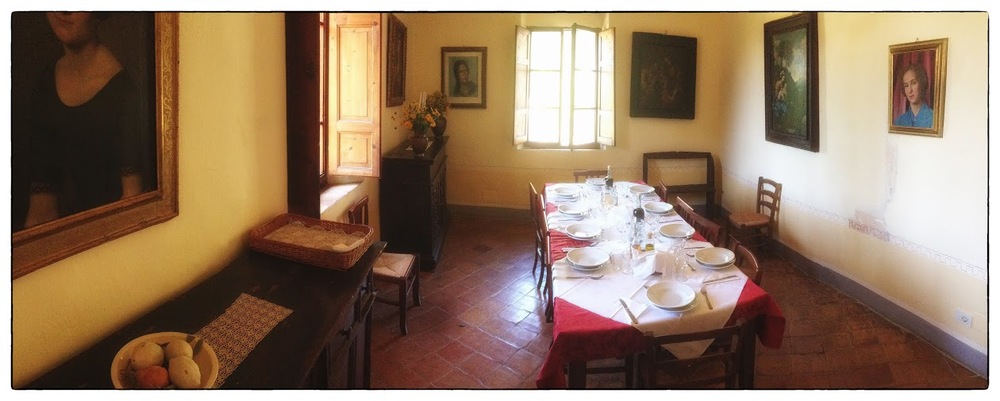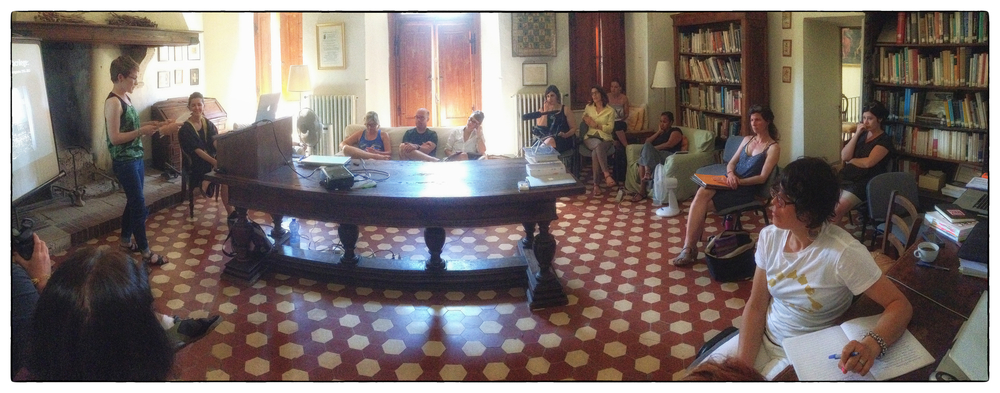Spannocchia
October 31, 2014
By Louise Carries Wales, Cohort ’13
Beautiful, bucolic Spannocchia—even its spoken tempo has a lyrical quality that inspires wonder. To all of us who have resided there, if only for a brief moment in time, Spannocchia signifies camaraderie, nurture and rigorous academic curiosity ... with, perhaps, a bit of mental stress mixed in for flavor. Add home style Italian cuisine and banquet tables for a secondary layer of meaning and allow it to simmer within memory. Spannocchia is magic.

I confess I was nervous embarking on the first of the IDSVA summer residencies. I was a late comer, and, as such, believed this poor timing would result in challenging inter-personal dynamics. On the contrary, I was warmly greeted by George Smith who, without hesitation, stopped all that he was doing and toured me through the tight complex of buildings.
Our first stop was the library, already a locus of creative ideation—a confluence of technology and frescoed walls—the weaving room in which thoughts were assembled from collective readings of Art and Theory. The space was populated by students deep in contemplation. My interruption of everyone’s concentration was met with smiles and handshakes. I could feel an immediate welcome and knew, in that instant, that the people here would become lifelong friends and colleagues. Over the weeks, speakers added to the list of interactions—among them Azra Aksamija, Simonetta Moro, Michael Smith and, of course, George Smith. These bonus talks added much to the fabric of our experience—not to mention revealing the depth of those whose voices we have heard throughout the year.
Spannocchia is synonymous with personal growth, achievement and an overcoming of fears we likely did not know we had. The rhythm of work, study groups, eating and individual dialog was punctuated with well-timed outings to nearby treasures. Florence and Siena were notable among these, as were the morning walks to visit the famous Cinta Senese piglets, bred at Spannocchia. We experienced both organic principles in action and works of art whose histories permeated the region. Emerging from discussions about the gaze, scopophila, fear of castration and the psychoanalytic effects of images, we walked various museum halls—experiencing the works first hand. Titian’s “Venus of Urbino” exposed herself to us through George’s lectures and our own immediate reaction. I found her eyes inescapable and her presence very much alive. Botticelli’s “Birth of Venus” is a feast of beauty and ornament, rich in narrative detail and history. Even the door jams and tile floors were exquisite — marking a period of precise craft and visual style.
These experiences allowed us to unwind and digest, explore and exchange ideas. The camaraderie sustained each one of us through the challenges of publicly presenting our writing—something that, at times, had the quality of baring one’s soul and becoming utterly vulnerable. We felt ourselves deeply and experienced our ideas concretely. We blended oils on canvas with gelato, notions of dérive with traces of the Medici in the structures bridging the Arno. We had sore feet and we loved it.
Perhaps the only way to extract us from Spannocchia’s spell was to propel us into the streets of Paris—the city of love and lights. From the Arno to the Seine, the Uffizi to the Louvre, the process of connecting present to past continued, as have the friendships cemented along the way.

